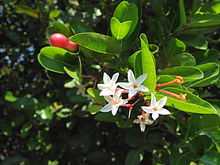Carissa carandas
| Carissa carandas | |
|---|---|
 | |
| Scientific classification | |
| Kingdom: | Plantae |
| (unranked): | Angiosperms |
| (unranked): | Eudicots |
| (unranked): | Asterids |
| Order: | Gentianales |
| Family: | Apocynaceae |
| Genus: | Carissa |
| Species: | C. carandas |
| Binomial name | |
| Carissa carandas L. | |
| Synonyms | |
| |
Carissa carandas is a species of flowering shrub in the dogbane family, Apocynaceae. It produces berry-sized fruitsphoto that are commonly used as a condiment in Indian pickles and spices. It is a hardy, drought-tolerant plant that thrives well in a wide range of soils. Common names include karonda (Devanagari: करोंदा), karamardaka (Sanskrit), vakkay (Telugu), kilaakkaai/கிலாக்காய் (Tamil). Other names less widely used include: karau(n)da, karanda, or karamda. It is called kerenda in Malaya, karaunda in Malaya and India; Bengal currant or Christ's thorn in South India; nam phrom, or namdaeng in Thailand; and caramba, caranda, caraunda and perunkila in the Philippines.[1] In Assam it is called Karja tenga. In Bengali it is called as Koromcha.
The supposed varieties congesta and paucinervia actually refer to the related conkerberry (C. spinarum).
Distribution
Carissa carandas grows naturally in the Himalayas at elevations of 300 to 1800 meters, in the Siwalik Hills, the Western Ghats and in Nepal and Afghanistan. It flourishes well in regions with high temperatures. In India it is grown on a limited scale in Rajasthan, Gujarat, Bihar and Uttar Pradesh. It is also grows in the Sri Lanka lowland rain forests.
Propagation
The plant is grown from seed sown in August and September. Vegetative propagation also is practiced in the form of budding and inarching. Cuttings may also succeed. The first monsoon shower is planting time. Plants raised from seed start bearing two years after planting. Flowering starts in March and in Northern India the fruit ripens from July to September.
Uses

The fruit is a rich source of iron, so it sometimes used in treatment of anaemia.[citation needed] It contains a fair amount of Vitamin C and therefore is an antiscorbutic.
Mature fruit is harvested for pickles. It contains pectin and accordingly is a useful ingredient in jelly, jam, syrup and chutney. Ripe fruits exude a white latex when severed from the branch.
The roots of the plant are heavily branched, making it valuable for stabilizing eroding slopes.
References
- ↑ Morton, J. 1987. Karanda. p. 422–424. In: Fruits of warm climates. Julia F. Morton, Miami, FL.
- K.L. Noatay (2004), "Karonda, the pickle berry", India Tribune, retrieved June 4, 2007.
- Shashi K. Sharma and S.D. Badiyala (2002), "Karonda, fruit plant for marginal lands", India Tribune, retrieved June 1, 2007.
External links
| Wikimedia Commons has media related to Carissa carandas. |
| Wikispecies has information related to: Carissa carandas |